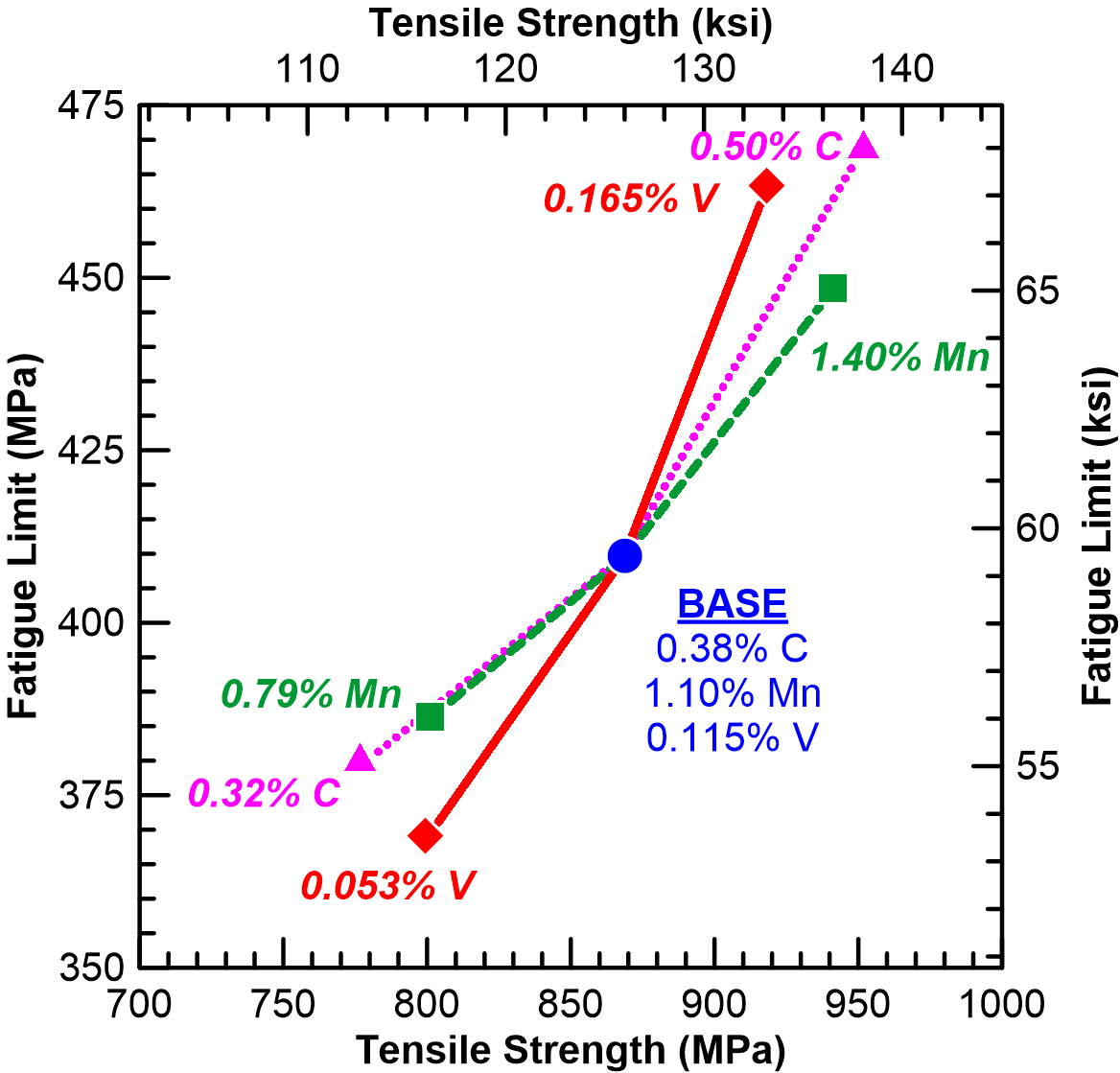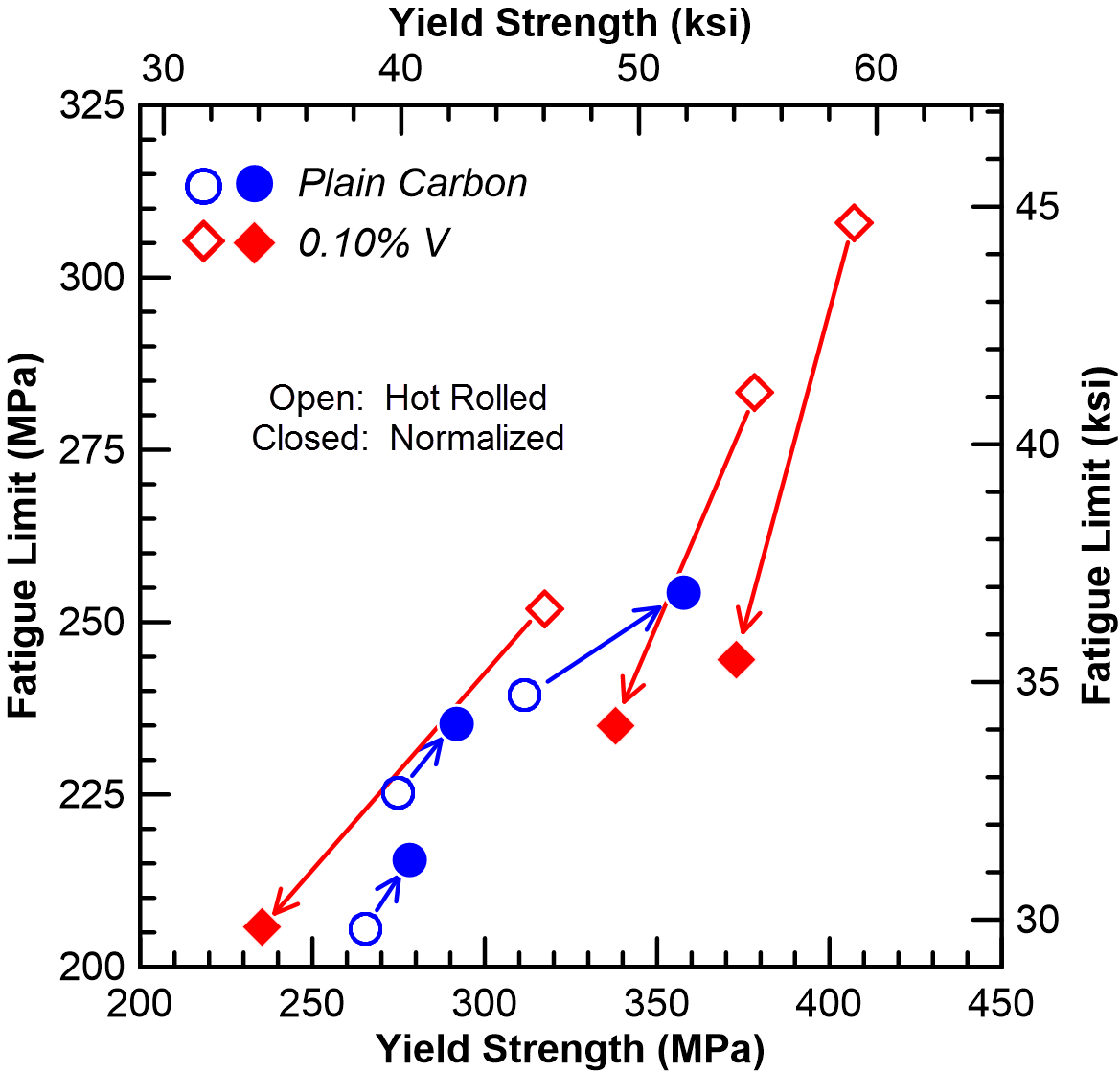Combining both alloying and processing into a single strategy to achieve a desired level of performance sounds like a simple concept, but can be challenging to accomplish. The endless pursuit of cheaper, lighter materials with reduced processing that meet or exceed previous component performance can be costly. Continual improvement practices often exploit incremental cost or performance enhancements to stay competitive in the marketplace, but not without risk.
One conceivable scenario could be slightly modifying the material of an existing part to achieve slightly higher mechanical properties and, as a result, higher perceived performance. An example increasingly seen in literature is the use of vanadium microalloyed steels in conventional heat-treated or secondary processed (e.g., induction hardened) components. This column briefly examines some of the benefits, as well as the drawbacks, of vanadium microalloyed steels in such a scenario.
Vanadium Microalloyed Steel Forgings
One application that successfully improves cost savings through a coupled alloying and processing strategy is direct-cooled vanadium microalloyed steel forgings. Their improved strength and hardness over plain carbon ferrite-pearlite steels is a result of nanometer-sized vanadium carbides and nitrides that precipitate from austenite during the transformation to ferrite and pearlite upon cooling. These steels have been shown to perform comparably to quench and tempered martensitic steels in specific applications [1]. Although not necessarily suitable as a comprehensive replacement for quench and tempered steels, the immense cost savings that the direct-cooling concept gains through processing reduction by far offset the cost of the 0.1 wt. % vanadium alloying addition required to achieve design requirements.
Since their introduction, these steels have seen use in a variety of applications that deviate from their original direct-cooled process design, and sometimes with mixed success. Such applications include automotive power transmission shafts, quench and tempered springs, and heavy section forgings for the oil and gas industry [2]. Improvements in specific performance characteristics such as torsional load, torsional fatigue life, and tempering resistance have been observed, but so have detrimental effects such as reduced toughness and strength [2].
Vanadium Carbide and Nitride Solubility
Successful implementation of vanadium microalloying into any process relies on understanding the solubility of the vanadium carbides and nitrides, since their existence within the microstructure is the reason for its improved performance. Therefore, understanding how thermal processing can influence both precipitate size and distribution is critical in implementing vanadium microalloying as an alloying strategy. The solubility of microalloy carbides and nitrides is a complex subject on which entire book chapters have been written (see Gladman [3]), so it is introduced here only for awareness.
The derivation of a solubility product is thermodynamic; however, because these products are determined experimentally, it is challenging to completely negate kinetic effects. As a result, solubility products from literature are best used only as a first approximation. For the purpose of discussion, the solubility product for vanadium nitride (VN) in austenite is:
 Equation 1
Equation 1
where vanadium (V) and nitrogen (N) are in wt.%, and solubility temperature (T) is in Kelvin [3]. This equation can be used to determine a great deal of information, but the simplest and most useful value calculated from this equation is the approximate temperature, or solubility temperature, at which a compound may either precipitate from austenite upon cooling or dissolve in austenite upon heating. In the case of a steel that contains 0.10 wt. % V and 70 ppm N, the associated solubility temperature is 1,030°C (1,886°F); therefore, if the steel is to be thermally processed, doing so above the solubility temperature allows precipitation upon cooling to be maximized.
Performance of Vanadium Microalloyed Ferrite-Pearlite Microstructures
Vanadium microalloyed steels were specifically designed for applications requiring forged and direct-cooled ferrite-pearlite microstructures, so they also work well in the hot-rolled condition. The data in Figure 1 indicate that there are multiple alloy strategies for medium-carbon hot-rolled steels that achieve similar properties, including vanadium microalloying [4]. This emphasizes the point that each process is different and needs to be fully evaluated before implementing a change of this magnitude.


Conclusion
Ultimately, understanding the complete processing of the material from steel supplier through final machining is the foundation for optimizing properties and minimizing costs. Direct-cooled vanadium microalloyed steels for forging applications are an excellent example of a coupled alloy processing strategy that reduces costs without sacrificing specific performance requirements. This article is a glimpse into the complexities involved in selecting the best material for an application.
References
- G. Krauss, Steels – Processing, Structure, and Performance, ed. 2, ASM International, Materials Park, OH, 2015.
- L.M. Rothleutner, C.J. Van Tyne, R.J. Glodowski, J.G. Speer, and D.K. Matlock, “Contributions of Vanadium to Properties of Heat Treated Medium Carbon Forging Steels.” In HSLA Steels 2015, Microalloying 2015 & Offshore Engineering Steels 2015: Conference Proceedings, John Wiley & Sons, Inc., pp. 419-425, 2015.
- T. Gladman, Physical Metallurgy of Microalloyed Steels, Institute of Materials, 1997.
- I. Nomura, “Influences of Microstructures of Fatigue Strength of Medium Carbon Microalloyed Steels,” Tetsu-to-Hagane (J. Iron Steel Inst. Jpn.), vol. 83, no. 3, pp. 227-232, 1997.
- D. Herring, “Metal Urgency – Compelling Reasons Normalizing Produces High Quality Gears,” Thermal Processing for Gear Solutions, pp. 16-17, Nov. 2012.
- T. Abe, T. Sampi, H. Osuzu, and I. Kozasu, “Quantitative Correlation of Static Strengthening Mechanisms to Fatigue Property in Low and Medium Carbon Steels,” Tetsu-to-Hagane (J. Iron Steel Inst. Jpn.), vol. 70, no. 10, pp. 1459-1466, 1984.
































